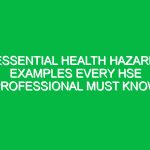Welcome to Today’s Toolbox Talk
Good morning, team! I appreciate everyone gathering here today. As we gear up for a productive day ahead, it’s essential to take a moment to focus on our Safety protocols. Today, we’re diving into a vital concept within the Health, Safety, and Environment (HSE) domain: the Hierarchy of Controls. Understanding this framework is key to identifying and mitigating risks in our workplace, ultimately leading to a safer environment for all of us.
What is the Hierarchy of Controls?
The Hierarchy of Controls is a systematic method used to minimize or eliminate exposure to Hazards. It prioritizes different Safety Measures, ranging from the most effective (elimination) to the least effective (personal protective equipment). This hierarchy helps us make informed decisions when it comes to protecting ourselves and our coworkers.
The Five Levels of the Hierarchy of Controls
Let’s break it down into its five levels:
- Elimination: This is the most effective control. It involves completely removing the hazard from the workplace. For example, if a particular machine poses a risk, redesigning the process to eliminate the need for that machine altogether would be ideal.
- Substitution: This involves replacing a hazardous material or process with a safer alternative. For instance, using water-based paints instead of solvent-based ones reduces harmful chemical exposure.
- Engineering Controls: These controls involve isolating people from the hazard. Installing guards or using ventilation systems to control airborne contaminants is a good example.
- Administrative Controls: This level includes changes to how people work. Implementing safer work practices or providing Training to employees on hazard recognition falls under this category.
- Personal Protective Equipment (PPE): This is the last line of defense. While essential, PPE should never be the sole protection against Hazards. Examples include gloves, helmets, and Safety Goggles.
Why is the Hierarchy of Controls Important?
Understanding the Hierarchy of Controls is crucial for several reasons:
- Prevention of Accidents: By systematically addressing hazards, we significantly reduce the likelihood of accidents and injuries.
- Compliance with Regulations: Many Safety regulations require organizations to implement controls in accordance with this hierarchy. Failing to do so can lead to legal repercussions.
- Cost Savings: Investing in effective controls can reduce costs associated with workplace accidents, such as medical expenses, lost productivity, and potential fines.
- Promotes a Safety Culture: Emphasizing the Hierarchy of Controls fosters a culture of safety within the workplace, encouraging everyone to take responsibility for their own safety and that of their colleagues.
Real-Life Application of the Hierarchy of Controls
Let’s consider a hypothetical scenario to illustrate how the Hierarchy of Controls works in practice:
Imagine we are working in a warehouse where heavy lifting is common. Employees are at risk of back injuries due to improper lifting techniques. Here’s how we might apply the hierarchy:
- Elimination: Redesigning the workflow to eliminate heavy lifting altogether.
- Substitution: Using automated lifting devices to handle heavy items instead of manual lifting.
- Engineering Controls: Installing conveyor belts to transport heavy items, reducing the need for lifting.
- Administrative Controls: Training employees on proper lifting techniques and scheduling breaks to avoid fatigue.
- PPE: Providing back support belts to employees lifting heavy loads as a last resort.
Implementing the Hierarchy of Controls in Your Daily Operations
Now that we understand the Hierarchy of Controls, let’s discuss how to integrate this framework into our daily operations:
- Identify Hazards: Always be on the lookout for potential hazards in your work environment. Regularly review tasks and processes to spot risks.
- Assess Risks: Determine the likelihood and severity of hazards to prioritize which ones to address first.
- Implement Controls: Choose the most effective Control Measures based on the hierarchy and ensure they are put into practice.
- Monitor and Review: Continuously monitor the effectiveness of the controls and make adjustments as necessary. Regularly review safety practices during Toolbox Talks.
Engaging in Open Dialogue
At this point, I’d like to open the floor for discussion. What challenges have you faced in identifying or implementing the Hierarchy of Controls? Are there specific situations where you’ve seen these principles applied effectively or where improvement is needed?
Feel free to share your thoughts or experiences. Remember, the goal of our Toolbox Talk is to learn from each other and enhance our safety practices.
Best Practices for Implementing the Hierarchy of Controls
To ensure we are effectively utilizing the Hierarchy of Controls, consider these Best Practices:
- Stay Informed: Keep up with the latest safety regulations and industry Standards related to your work.
- Engage in Training: Participate in safety training sessions to enhance your understanding of risk management and control strategies.
- Communicate: Encourage open communication about safety concerns and suggestions for improvement among team members.
- Document Hazards: Maintain a record of identified hazards and the Control Measures implemented. This documentation can help in reviewing effectiveness over time.
Regulations and Standards
Understanding the regulatory context of the Hierarchy of Controls is crucial. Compliance with regulations such as OSHA (Occupational Safety and Health Administration) standards is not just a legal obligation; it also reflects our commitment to maintaining a safe workplace. Familiarize yourself with the specific regulations that apply to our industry and how they influence our safety practices.
Conclusion
To wrap up today’s Toolbox Talk, I want to emphasize that the Hierarchy of Controls is not just a theoretical concept; it’s a practical tool we can all use to enhance our safety practices. By eliminating or reducing hazards in our workplace, we contribute to a safer environment for ourselves and our colleagues.
Thank you all for your attention and for your commitment to safety. Remember, each of us plays a crucial role in maintaining a safe working environment. Let’s continue to work together to implement the Hierarchy of Controls in our daily operations. Stay safe out there!


